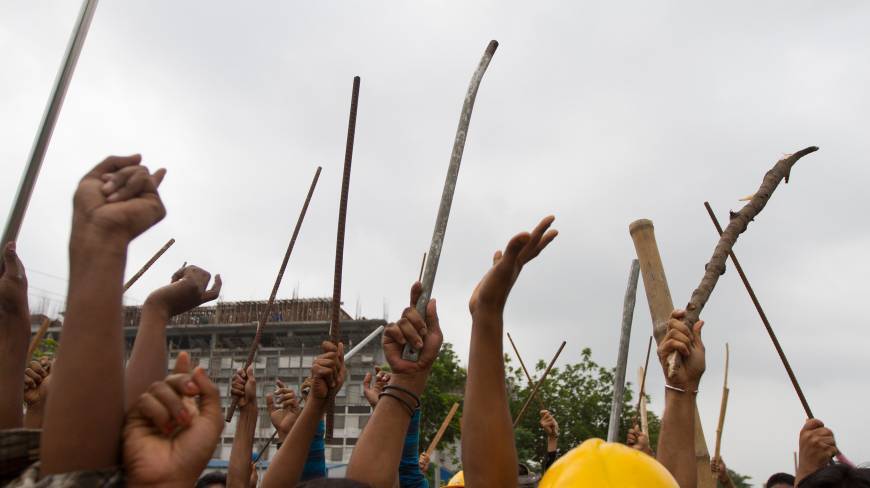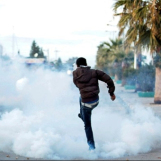Με αφορμή την καταστολή των καταλήψεων στην Πάτρα αναδημοσιεύουμε από το περιοδικό blaumachen#6 το κείμενο-εισήγηση του συντρόφου Α.σε εκδήλωση/συζήτηση που έγινε στην καταάληψη κτήματος Πραπόπουλου το Μάρτη του 2013.
Αντικείμενο της εκδήλωσης αποτελεί το ζήτημα της κρατικής καταστολής στις καταλήψεις. Αφορμή στάθηκαν σίγουρα οι επιθέσεις στις καταλήψεις και τα αυτοοργανωμένα εγχειρήματα γύρω από την πλατεία Βικτωρίας, και το πώς αυτές έγιναν αντιληπτές όχι μόνο από τους συμμετέχοντες σε αυτά αλλά και από το υπόλοιπο «ανταγωνιστικό κίνημα»· όμως στόχος της εισήγησης δεν είναι να περιοριστεί στην ερμηνεία αυτών των επιθέσεων και να ενισχύσει την ψευδαίσθηση μιας αντιπαλότητας μεταξύ ενός «εμείς»[1] και ενός κράτους εννοημένου ως διμοιρίας δελτάδων.
Αν υπάρχει λοιπόν ένα πρώτο ζητούμενο της σημερινής κουβέντας, αυτό είναι η έμφαση στην κοινή μοίρα μεταξύ ντόπιων αντιεξουσιαστών και μεταναστών προλετάριων, κοινής μοίρας όμως ως κομμάτι του συνεχώς διευρυνόμενου υπερπληθυσμού. Και αυτό είναι κάτι που ίσως δεν τονίστηκε όσο έπρεπε κατά τις πρόσφατες επιθέσεις στις καταλήψεις. Σίγουρα πρόκειται για μεγάλο θέμα που μπορεί να μη χωράει σε μια κουβέντα μερικών ωρών, αλλά είναι χρήσιμο να το έχουμε στο μυαλό μας ως μια έννοια-ομπρέλα, η οποία διατρέχει από τη μια άκρη ως την άλλη το θέμα μας.
Από εκεί και πέρα, η αναφορά σε μορφή και περιεχόμενο της κρατικής καταστολής αναπόφευκτα εμπεριέχει μια αντίληψη για το τι είναι το κράτος και ποιος είναι ο ρόλος του στην παρούσα συγκυρία. Αν και σε γενικές γραμμές άργησε να γίνει αντιληπτό το ποιοτικό άλμα στην κρατική καταστολή που καθιστά την αστυνομία ως τη βασική διαμεσολάβηση των κοινωνικών συγκρούσεων σε όλα τα επίπεδα, εντούτοις έχω την εκτίμηση ότι στους λεγόμενους ανατρεπτικούς κύκλους έχει μείνει πίσω η κουβέντα για το τι είναι το κράτος και από πού προκύπτει η αναγκαιότητά του τόσο σε μια καπιταλιστική κοινωνία γενικά όσο και στη σύγχρονη καπιταλιστική κοινωνία ειδικά. Οπωσδήποτε η έννοια του κράτους έκτακτης ανάγκης, καθώς και η έννοια της μηδενικής ανοχής, είναι θεωρητικά χρήσιμες, αλλά έχω την αίσθηση ότι τις περισσότερες φορές σχετίζονται μονοκόμματα με τη στρατιωτικοποίηση του κρατικού μηχανισμού και το δόγμα της ασφάλειας. Υιοθετώντας μια πιο διαλεκτική προσέγγιση στη σχέση του κράτους με τις μορφές της ταξικής πάλης, ειδικά υπό συνθήκες κρίσης της συσσώρευσης κεφαλαίου, θα μπορούσαμε να πούμε πως ένα από τα βασικά χαρακτηριστικά αυτού που αποκαλείται σήμερα κράτος έκτακτης ανάγκης είναι να ορίζει (και να ορίζεται από το) τι είναι υπερπληθυσμός και πως ο διαχωρισμός, η ταξινόμηση, ο στιγματισμός, ο αποκλεισμός, η καταστολή του ποιος είναι κατάλληλος για αξιοποίηση και ποιος όχι συνιστούν τις κατεξοχήν λειτουργίες του. Και μεταξύ άλλων, φυσικά, αυτές έχουν και μια χωρική διάσταση όσον αφορά την αξιοποίηση της ακίνητης περιουσίας, τη διαφύλαξη του ποσοστού κέρδους από τη γαιοπρόσοδο σε αστικό περιβάλλον κ.α.
Αν λοιπόν υπάρχει ένα δεύτερο ζητούμενο από τη σημερινή συζήτηση, είναι να αναδειχθούν τα χαρακτηριστικά του σύγχρονου κράτους έκτακτης ανάγκης και, αν θέλετε με πιο «βαρείς» θεωρητικούς όρους, η αναγκαστικά βιοπολιτική του διάσταση σε συνθήκες πραγματικής υπαγωγής όχι μόνο της εργασίας, αλλά και ολόκληρου του κοινωνικού σχηματισμού, στο κεφάλαιο. Θα το ξαναπώ εδώ βέβαια πως σίγουρα ένα τέτοιο θέμα συζήτησης θα μπορούσε να απασχολήσει όχι μόνο μία, αλλά πολλές και πολύωρες συζητήσεις. Τουλάχιστον ας το έχουμε στο μυαλό μας μαζί με όσα θα ακολουθήσουν.




